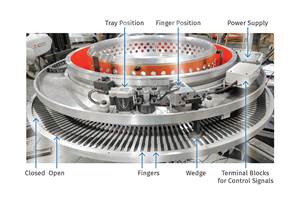Study May Boost Prospects For Single-Screw ‘Elongator’
Dow Chemical Co., Midland, Mich., weighed in at last yearÔÇÖs SPE ANTEC with a paper discussing results of experiments they conducted on a novel elongational mixing device developed by Randcastle Extrusion Systems
Has the heated debate over whether a single screw can possibly provide elongational mixing akin to a twin screw now been settled? Researchers from Dow Chemical Co., Midland, Mich., weighed in at last year’s SPE ANTEC (May 1-5 in Boston) with a paper discussing results of experiments they conducted on a novel elongational mixing device developed by Randcastle Extrusion Systems, Cedar Grove, N.J.
The paper, delivered by Dow scientist Dr. Stephane Costeux, discussed the results of mixing tests using Randcastle’s SFEM series batch mixers versus a batch-mixing bowl, both running TPO blends of 70% polypropylene and 30% ethylene copolymers. The batch mixer had the same basic geometry as Randcastle’s SFEM patented elongational mixer for single screws, introduced in 2008.
Dow’s testing confirmed that where typical batch mixers are shear-dominant, the Randcastle mixer has “stronger extensional flow” to achieve better TPO dispersion. The Dow study also used a Randcastle single-screw extruder with similar mixing geometry to determine that the “SFEM’s primary deformation mode is elongational (as opposed to shear-dominated),” and added that “a single-screw extruder equipped with SFEM mixing elements achieved even finer dispersion, usually achievable only with twin-screw extruders.”
Keith Luker, president of Randcastle, has been touting the elongational mixing capabilities of his device since he first developed it. The response, by and large, has been skeptical, as twin-screw extruders are generally considered the gold standard where mixing is concerned.
“Elongation is a stretching force; its opposite is compression,” explains Luker. “Compression pushes material together, as in the compression section of a screw. If you take a cylinder and push on it from all sides nothing will happen. Take the same volume of a cylinder and stretch it out into a film, and you get an exponential increase in surface area. That quantifies the mixing improvement. The key is the pulling surface that stretches material from the inlet channel—just as nip rolls pull.” (See illustration of how it works.)
The Dow paper also addressed the matter of scale-up: “The most important attribute of mixing equipment used to make such small-scale blends is that it achieves a degree of mixing or morphology that is consistent with that obtained with large-scale compounding equipment. If the geometry of the batch mixer is very different from the mixing-element geometry of the large-scale process (often involving a single-screw extruder), translation of laboratory formulation results to commercial scale becomes extremely challenging.”
But Luker notes that the batch and screw SFEM mixers have essentially the same geometry. “You expect the same geometry to scale up,” states Luker. “You do not expect mixing-bowl geometry to scale up to because it does not resemble a single screw.”
Luker notes that a previous paper delivered at ANTEC 2008 by Drs. Jennifer Lynch and Tom Nosker of the Dept. of Ceramic and Materials Engineering, Rutgers University, New Brunswick, N.J., confirmed the scale-up from batch mixer to extruder screw.
Commercial applications of Luker’s SFEM elongational mixer to date include mixing of 35% calcium carbonate in a direct-extrusion application; mixing immiscible materials for pipe; mixing large mica flakes for pearlescent compounds; and blending high- and low-viscosity polymers.
Luker says it takes only two mixing sections in a 24:1 LD screw to get about 125 times better mixing, or three mixers in a 32:1 LD to give you about 1000 times better mixing, than with a standard single screw.
Related Content
New Blown-Film Cooling Technologies Set to Debut at NPE2024
Cooling specialist Addex to roll out new auto-profiling air ring for rotating dies, and new single-plenum air ring.
Read MoreDeflection Elbows Eliminate Streamers for Large Film Processor
New elbows eliminate troublesome streamers to increase productivity at leading blown film processor.
Read MoreFollow These Tips to Fire Up Your Cold Blown Film Line
Firing up a cold blown-film line after a shutdown involves multiple pieces of equipment that all interact. Here’s a look at those components individually and some best practices on how to get your line up and running as quickly and safely as possible.
Read MoreWhat You Need to Know About Roll-Cooling Design
Cooling rolls might not look like high-tech machines, but the fact is there is a surprising amount of technology involved in their design, manufacture and use. Here’s what you need to know.
Read MoreRead Next
Lead the Conversation, Change the Conversation
Coverage of single-use plastics can be both misleading and demoralizing. Here are 10 tips for changing the perception of the plastics industry at your company and in your community.
Read MoreMaking the Circular Economy a Reality
Driven by brand owner demands and new worldwide legislation, the entire supply chain is working toward the shift to circularity, with some evidence the circular economy has already begun.
Read MoreSee Recyclers Close the Loop on Trade Show Production Scrap at NPE2024
A collaboration between show organizer PLASTICS, recycler CPR and size reduction experts WEIMA and Conair recovered and recycled all production scrap at NPE2024.
Read More












